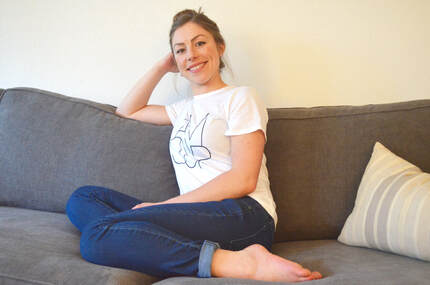 I remember a powerful tool in my gymnastics and dance career being imagination: visualizing myself doing every kick, leap, turn, jump, release, and flip. Slowing down and picturing exactly how I wanted to move my body, what I wanted to look liked, and what the sequence of moves were. Turns out, that actually had invaluable power! I am going to get nerdy on this one.
Join me? Science tells us that imagining an act engages the same sensory-motor systems in the brain that are involved in doing it, helping us learn to do it better. First, some interesting background. Back in 1904, a forward-thinking Spanish neuro-anatomist and Nobel laureate, Santiago Ramon y Cajal, argued that thoughts, repeated in "mental practice," must strengthen the existing neuronal connections and create new ones. But he lacked the tools to prove it. Later on, Alvaro Pascual-Leone M.D. Ph.D tested this theory of mental practice and imagination leading to physical changes. The results, pretty staggering... They taught two groups of people to play the piano, who had never studied it before. Each group was taught a sequence of notes with instruction on which fingers to move, hearing the notes as they were played. The "mental practice" group sat in front of an electric piano keyboard, two hours a day for five days, and imagined both playing the sequence and hearing it played. The other "physical practice" group actually played the music two hours a day for five days. Both groups had their brains mapped before, during, and after the experiment. At the end of the fifth day, the neural changes in the motor signals to the muscles were the same in both groups, and the "mental practice" players were as accurate as the "physical practice" players were on their third day. With just two hours of physical practice for the "mental practice" group, their overall performance improved to the level of the physical practice group at five days. Thus, they found mental practice, or imagination, to be a highly effective preparatory tool for learning a physical skill with minimal physical practice. Another study shows that imagining using muscles actually strengthens them. Drs. Guang Yue and Kelly Cole looked at two groups, one that did physical exercises and one that imagined doing the exercises. Both exercised a finger muscle 5 days a week for one month. The physical group did 15 maximum voluntary contractions with a 20 second break in between each repetition. The mental group imagined doing these 15 maximum voluntary contractions with a 20 second break in between each, while also imagining a voice saying "harder, harder, harder!" At the end, the physical exercise group increased their muscle strength by 30 percent. Those who only imagined doing the exercise increased their strength by an incredible 22 percent. The explanation, according to Normal Doidge M.D. (author of The Brain That Changes Itself, read it!), lies in the motor neurons of the brain responsible for movement. While imagining, the neurons responsible for putting together sequences of movements are activated and strengthened, leading to greater physical strength, whether you are actually moving or not. My training in the Anat Baniel Method proved these concepts to be true. It gave imagination an even greater meaning than what I had once thought as a learning and developing gymnast and dancer. I experienced in my own body the ability to do seemingly impossible odd movements that physical practice alone did not allow. As an able-bodied person, I felt the power of imagination to be intensely alive and active. Think about the implications that could have for recovery, rehab, and aging! But, for children with special needs, their spontaneous ability to imagine may be fully or partially limited. Therefore, it is of upmost importance that we help them gain access to this human gift that healthy children rely on for learning and development. It's application just may look a little different. Here are some ideas that Anat Baniel suggests in her book, Kids Beyond Limits: Make believe play. Turn serious or structured activities into a game filled with imagination, making them more fun and effective. It engages the child and wakes up their creative powers. Create imaginative scenes and stories. Introduce imaginary ideas and suggestions as you interact with your child, and look for signs he/she is trying to join in. If your child is verbal, listen carefully and add those ideas and details to the image, story, or game that you are creating. It may not make sense, but that does not matter. It is all imaginary anyway! Daydream together. Take a break and "co-daydream" by thinking about a place you would like to be right now. Embellish it a little bit, bring in more detail. Ask your child to describe what she would be doing if he/she were there right now. Introduce movement and music to the dream. Have fun! Honor you child's dreams. We all have dreams, big or small. So remember that your child's dreams are his/her dreams, not your dreams or hopes for him/her. Take interest in your child's dreams, treat them with respect, and honor them. Try your best not to project your dreams for your child on him or her. Instead, help them feel heard and empowered! In the words of Anat Baniel, "Imagination has the power to upgrade the quality of functioning" in all of our brains, "creating new pathways and inventing new and refined ways of moving, thinking, and feeling." Imagination turns on the lights throughout the brain. While we may not know exactly how it actually changes brain structure, we know that it does. Go use imagination in your own life, and have fun inventing ways of using it with your child. Who knows what could happen.
0 Comments
Your comment will be posted after it is approved.
Leave a Reply. |
meet the bloggerAusten is a pediatric occupational therapist with experience in schools, early intervention, and private clinic settings. She now runs her own private practice in Portland, OR specializing in movement based learning techniques. This blog's mission is to educate and empower parents and children by sharing insights into the complexities of learning and development. Categories
All
|
MINDFUL MOVEMENT THERAPIES
In-Home Pediatric Occupational Therapy in Portland, Oregon
phone503-720-4634
|
|
|

